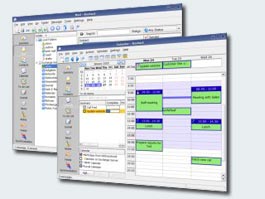Kontact
Template:I18n/Language Navigation Bar
 |
Kontact ist der integrierte persönliche Informations-Manager (PIM) von KDE. |
Die Kontact Programmsammlung vereinigt ausgereifte und bewährte KDE PIM Applikationen unter einem Dach. Aufgrund der mächtigen KPart-Technologie werden bestehende Applikationen nahtlos zu einer Applikation zusammengefasst.
Die Komponenten von KDE Kontact sind so maßgeschneidert, dass diese gut zusammenarbeiten. Dies resultiert zum Beispiel in einem intuitiven Ziehen-Und-Ablegen zwischen der Terminplanung, Aufgabenlisten und Kontakten. KDE Kontact unterstützt verschiedene Groupware-Server. Wenn diese Server verwendet werden, hat ihre Arbeitsgruppe Zugriff zu Funktionen wie freigegebene E-Mail-Ordner, gruppenspezifische Aufgabenlisten, gemeinsame Kalender, zentrale Adressbücher und Besprechungsplanung.
Zusammengefasst: KDE Kontact gibt Ihnen innovative Funktionen, um ihre Kommunikation einfacher zu gestalten, ihre Arbeit schneller zu organisieren und näher zusammenzuarbeiten. Daraus resultiert eine höhere Produktivität und Effizienz in ihrer digitalen Zusammenarbeit.
Komponenten
Diese Programme können in Kontact integriert werden:
- Akregator - Lesen Sie ihre bevorzugten Feeds
- KAddressBook - Pflegen Sie ihre Kontakte
- KJots - Organisieren sie ihre Ideen in Notizbüchern
- KMail - E-Mail-Programm
- KNode - Ihr Usenet Nachrichtenleser
- KNotes - Haftnotizen für Ihre Arbeitsfläche
- KOrganizer - Kalender und Terminplanung
- Ktimetracker - Halten Sie fest wie viel Zeit Sie für verschiedene Aufgaben verwendet haben
- Summary - Übersichtsseite in Kontact
Siehe auch
- * Wie versende ich eine SMS mit Kontact
Wo bekommt man Hilfe
There is a mailing list at
- kdepim-users - for users of the KDE PIM applications (Kontact, KAddressBook, KMail, KOrganizer, KNode, ...) [subscribe to kdepim-users] [archive of kdepim-users]. A team of developers and users aim to give answers as quickly as possible
and for urgent help, an IRC channel on Freenode
- for users and developers of Kontact - #kontact
FAQ, Hints and Tips
Migrating your setup to a new distro
In KMail, right click on your Inbox and choose Properties. Go the Maintenance Tab. Have a look at the Location. It has either .kde4 or .kde in the path.
Substitute the appropriate path below.
You need the following config files:
- .kde4/share/config/emaildefaults
- .kde4/share/config/emailidentities
- .kde4/share/config/kmail.eventsrc
- .kde4/share/config/kmailrc
- .kde4/share/config/kaddressbookrc
- .kde4/share/config/kresources/contact
- .kde4/share/config/korgacrc
- .kde4/share/config/korganizerrc
- .kde4/share/config/knotesrc
- .kde4/share/config/mailtransports
and the following directories:
- .kde4/share/apps/kmail
- .kde4/share/apps/kabc
- .kde4/share/apps/korganizer
- .kde4/share/apps/knotes
If you use Akregator within Kontact, you will also need:
- .kde4/share/config/akregator.eventsrc
- .kde4/share/config/akregatorrc
and the whole .kde4/share/apps/akregator directory.
Of course the simplest way is just to keep your whole home directory. :-)
Just a word of warning. If the directory naming is different between Desktops or between the two versions of your distro, this will not work as there are references to the directories within the config files. This means that if the files were in a .kde directory, you cannot just put them in a .kde4 directory without editing the references within the config files.
Hiding the Kontact Sidebar
On small screens, you may wish to reclaim the space used by the Kontact sidebar. You can replace it with an (editable) toolbar:
- Settings->Toolbars->Navigator [x]
- Drag the left panel closed using the splitter between it and the main panel, job done.
Enabling SOCKS support in KMail and KNode
Unlike KDE 3, KDE 4 does not have built-in SOCKS support yet. However, it is still possible and relatively simple to make KMail and KNode use a SOCKS proxy, by using proxychains or other similar tools like tsocks or socksify. Assuming that proxychains is correctly installed and configured, all you need to do is to open a terminal (e.g. Konsole) and type:
proxychains kdeinit4
You don't even need to restart KMail/KNode! (You need to type the above command every time you start a new KDE session though).
